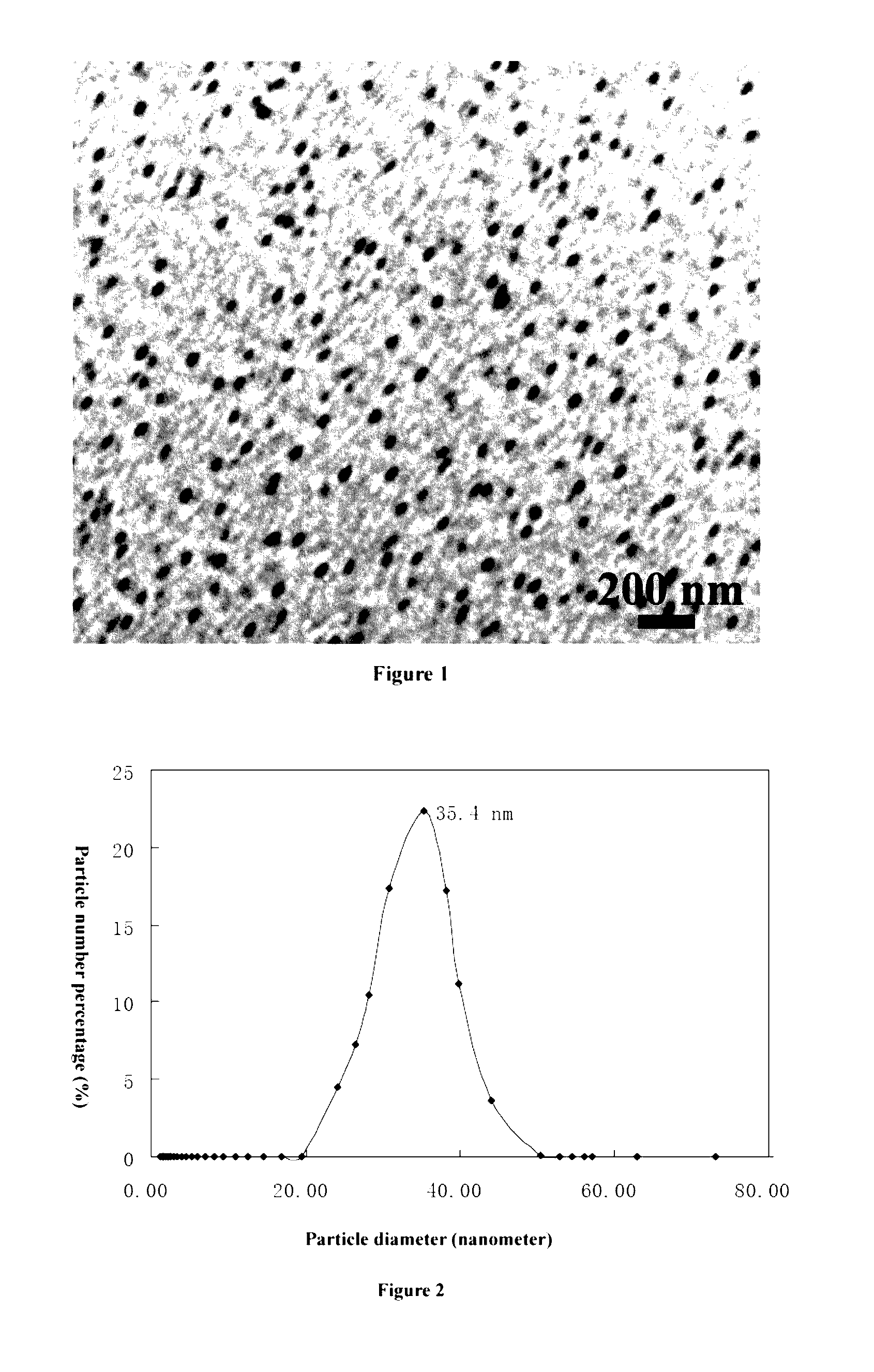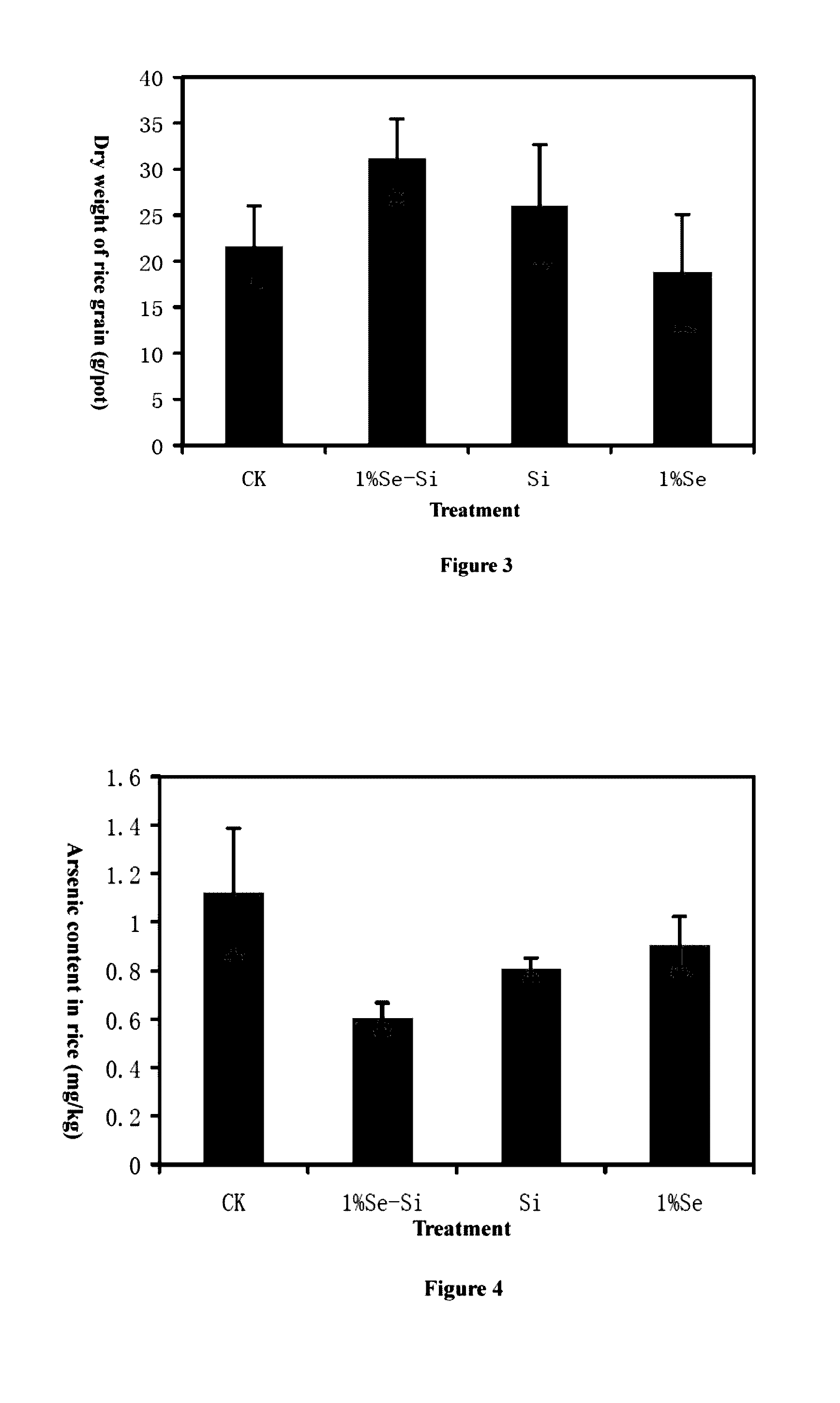Selenium-doped NANO silica sol used for producing selenium-enriched rice and capable of suppressing absorption and accumulation of heavy metals in paddy rice and preparation method therefor
a selenium-enriched rice and nano-silica technology, applied in the field of selenium-doped nano-silica sol, can solve the problems of not fundamentally solving the effective replenishment of selenium nutrition in the human body, small coverage area, direct economic loss of more than 20 billion cny, etc., to inhibit the absorption and accumulation of heavy metals in paddy rice, high concentration, and high stability
- Summary
- Abstract
- Description
- Claims
- Application Information
AI Technical Summary
Benefits of technology
Problems solved by technology
Method used
Image
Examples
example 1
[0037]Preparation of a selenium-doped nano-silica sol capable of both inhibiting the absorption and accumulation of heavy metal in rice and producing a selenium-rich rice.
[0038]200 mL of water was metered, 1 g sodium hydroxide was added, a stirrer was actuated, and the temperature was heated to 55° C., then 250 g Na2SiO3 was added, after sufficiently dissolved, the temperature was cooled to the room temperature, so as to obtain a metal silicate solution with a pH of 12.8, wherein the mass percentage of the metal silicate was 55.5%. The above-mentioned metal silicate solution was passed through a 100 mL (wet volume) of hydrogen-type strong acidic cation exchange resin multi-stage column in an uniform speed of 5 mL / min, the collected solution at the outlet of the column was controlled at a pH between 2˜3, the collected solution was heated to 50° C. with stirring by microwave (or water bath), then carried out standing, cooling, and aging for 30 min, so as to obtain an acidic silica sol...
example 2
[0039]Preparation of a selenium-doped nano-silica sol capable of both inhibiting the absorption and accumulation of heavy metal in rice and producing a selenium-rich rice.
[0040]200 mL of water were metered, 20 g potassium hydroxide was added, a stirrer was actuated and the temperature was heated to 85° C., then 15 g metallic silicon powder was added, after sufficiently dissolved, the temperature was cooled to the room temperature, so as to prepare a metal silicate solution with a pH of 13, wherein the mass percentage of the metallic silicon was 6.4%. The above-mentioned metal silicate solution was passed through a 100 mL (wet volume) of hydrogen-type strong acidic cation exchange resin multistage column in an uniform speed of 5 mL / min, the collected solution at the outlet of the column was controlled at a pH value between 2.5˜3.5, the collected solution was heated to 90° C. with stirring by microwave (or water bath), carried out standing, cooling, and aging for 30 min, so as to obta...
example 3
[0041]Preparation of a selenium-doped nano-silica sol capable of both inhibiting the absorption and accumulation of heavy metal in rice and producing a selenium-rich rice.
[0042]200 mL 5% by mass of dilute aqueous ammonia was metered, a stirrer was actuated and the temperature was heated to 35° C., then 50 g K2SiO3 was added, after sufficiently dissolved, the temperature was cooled to the room temperature, so as to prepare a metal silicate solution with a pH of 10.5, wherein the mass percentage of the metal silicate was 20%. The above-mentioned metal silicate solution was passed through a 100 mL (wet volume) of hydrogen-type strong acidic cation exchange resin multi-stage column in an uniform speed of 5 mL / min, the collected solution at the outlet of the column was controlled at a pH value between 2.5˜3.5, the collected solution was heated to 35° C. with stirring by microwave (or water bath), carried out standing, cooling, and aging for 30 min, so as to obtain an acidic silica sol pr...
PUM
 Login to View More
Login to View More Abstract
Description
Claims
Application Information
 Login to View More
Login to View More - R&D
- Intellectual Property
- Life Sciences
- Materials
- Tech Scout
- Unparalleled Data Quality
- Higher Quality Content
- 60% Fewer Hallucinations
Browse by: Latest US Patents, China's latest patents, Technical Efficacy Thesaurus, Application Domain, Technology Topic, Popular Technical Reports.
© 2025 PatSnap. All rights reserved.Legal|Privacy policy|Modern Slavery Act Transparency Statement|Sitemap|About US| Contact US: help@patsnap.com



